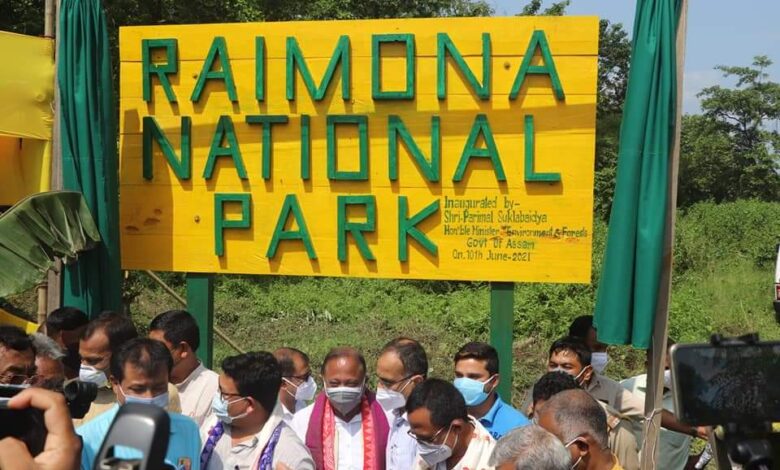The birth of a national park in Assam
In June this year, Assam declared Raimona as its 6th national park, spreading over 422 sqkm, in Kokrajhar

Bikash Kumar Bhattacharya & Jyotirmoy Saharia/Mongabay India
In his hunting journal Thirty-Seven Years of Big Game Shooting, the Maharaja of Cooch Behar, Nripendra Narayan Bhup Bahadur, notes that in a few days’ sport in the month of March, 1900, his hunting party had shot 11 tigers, 11 leopards, one rhino, three water buffaloes, five bears, one bison, two sambar, three hog deer and three pigs in the forests along the banks of the Saralbhanga river in the foothills of Bhutan.
These forests in the biodiversity-rich foothills, today, form part of Raimona National Park in Assam. Named after the historical capital of Bijni estate, Raimona, the park was declared on June 9, 2021, recognising the presence of the teeming biodiversity. It consists of contiguous forest patches covering an area of 422 sqkm. comprising the northern part of the notified Ripu Reserve Forest that forms the western-most buffer to Manas Tiger Reserve in the foothills of Eastern Himalaya Biodiversity Hotspot.
Known for its historical elephant habitats, the government of Assam had declared in 2003 Chirang-Ripu Elephant Reserve, with an area of 2,600 sq. km. The newly declared park, along with Manas National Park, is vital to trans-boundary movement of elephants and other wildlife through northern West Bengal, Bhutan and Arunachal Pradesh.
Legendary elephant herds
According to a census conducted by the Assam forest department in 1981 about an estimated 1,200 elephants were found in the Manas Tiger Reserve, which included the Raimona forests. Many legends have emerged surrounding the elephant herds of these forests, some of which have also found their way into popular literature. A folk tale narrates that a maiden clad in white saree commanded one of the largest elephant herds in these forests. Foresters and locals alike claim having seen this pagli sahan, meaning “the elephant herd commanded by the mad girl”. Gordon Casserly, a colonial writer, employed variants of this folk narrative in his novels, The Elephant God and The Jungle Girl.
These legendary elephant herds are now in peril owing to fragmentation of their habitats. A 2011 study by Aaranyak, a conservation NGO, reveals that elephant distributional range in the landscape has been heavily fragmented and shrunk primarily because of anthropogenic activities. “The highest level protection coming in the form of Raimona National Park therefore is a very welcome step. It will help arrest habitat loss and fragmentation,” says Jyoti P. Das, one of the authors of the study.
The park is also home to Gee’s golden langur (Trachypithecus geei), one of the world’s most endangered primates, endemic to Bhutan and Assam. The Ultapani and Ripu-Chirang reserve forests, now part of Raimona National Park, is also home to rare butterflies. Kushal Choudhury, zoologist and assistant professor at Kokrajhar Science College, who has worked extensively on the butterflies found in Raimona, documented two rare butterfly species in 2010. “A rare endemic butterfly species named the yellow-crested spangle (Papilio elephenor Doubleday) was sighted in Ripu-Chirang forests in 2009 after a long gap of 100 years,” says Choudhury, who published a paper in 2010 describing the two species.
The lepidopterist further says the road that darts through Ripu-Chirang forests connecting Kokrajhar to Saralpara has been a graveyard of butterflies. In addition to hosting more than 150 butterfly species and other rare species such as Bengal tiger, clouded leopard, gaur and chital, Raimona is also recognised as an Important Bird and Biodiversity Area (IBA) by BirdLife International for its avian biodiversity.
A transboundary landscape
Underscoring the significance of the landscape as a zone of connectivity, Assam’s forest department in a statement said that historically the Raimona forests were a part of the migratory route of the faunal species from Himalayan Mountain, Indo-Malayan and Indo-Chinese realms towards the west and Peninsular Indian realm species to the east.
The newly declared national park is part of a 2400 sq. km. transboundary conservation landscape sharing contiguous forest patches with Bhutan’s Phibsoo Wildlife Sanctuary and Jigme Singye Wangchuk National Park.
Studies such as a 2018 camera trapping survey on terrestrial animals in Manas National Park have shown that transboundary management of wildlife is beneficial to preserving biodiversity in the face of conflicts and other disturbances. The Assam and Bhutan forest departments have been experimenting in transboundary landscape level ecosystem management in Manas National Park and Royal Manas National Park by developing Transboundary Manas Conservation Area (TraMCA).
Ecotourism potentials
The birth of the new national park, sixth in the state, has also brought hopes of boosting tourism in western Assam which sees relatively less tourist inflow. Zoologist Choudhury of Kokrajhar Science College says that the richness of butterfly biodiversity in the park, which is unique in the region, could be a good tourist attraction in Raimona. However, he suggests a cautious approach which ensures that tourism doesn’t have negative effects on the butterfly population.
Local people living in the fringe areas of the park depend on the forest for food, fuel, medicine, grazing and house construction materials.
While some local villagers are apprehensive that the declaration of the park could curtail certain rights they have traditionally exercised over these forests, Khampha Basumatary, a former Bodo insurgent and local leader in Saralpara, exudes hope that the establishment of the park will alternatively open up eco-tourism opportunities for the villagers and local entrepreneurs.
(The article first appeared in Mongabay India. For full article, visit india.mongabay,com)




